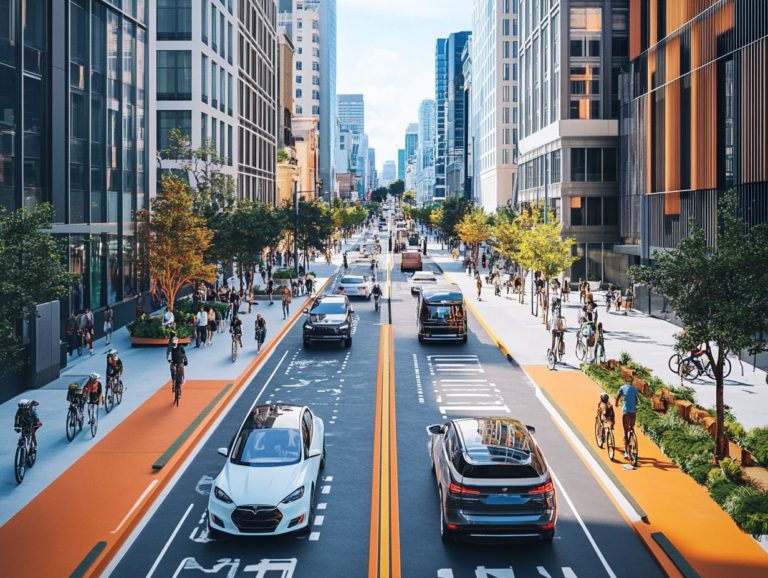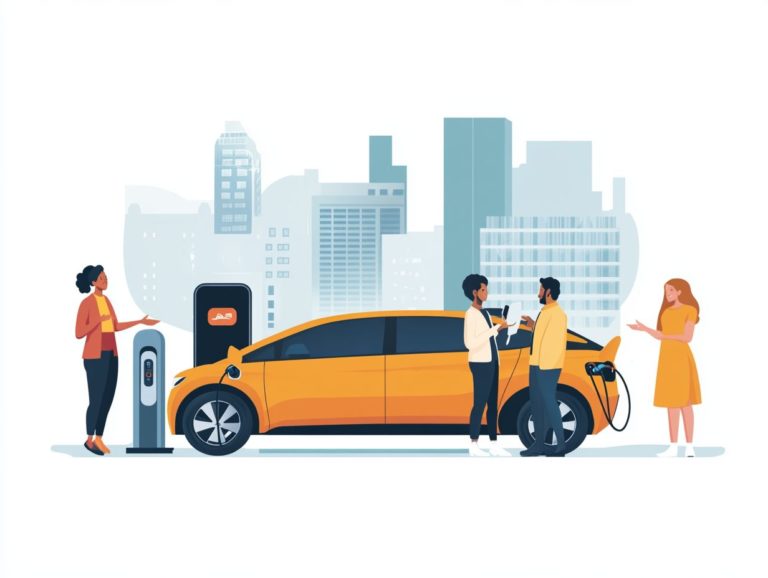The Intersection of EVs and Smart Cities
In a time when urban living is undergoing a remarkable transformation, the concept of smart cities is changing how you interact with the environment.
These cities harness technology and innovation to elevate the quality of life for their residents. Integrating electric vehicles (EVs) is crucial for this evolution.
This article explores what smart cities are all about, examines the role of EVs within them, discusses the challenges they encounter, and considers their potential future impact.
Explore the exciting link between smart cities and electric vehicles, and envision the possibilities that lie ahead.
Contents
- Key Takeaways:
- The Concept of Smart Cities
- EVs in Smart Cities
- Challenges in Smart Cities
- The Future of EVs and Smart Cities
- Frequently Asked Questions
- What is the intersection of EVs and smart cities?
- How are we bringing EVs to our smart cities?
- Discover the amazing benefits of combining EVs with smart cities!
- What challenges do we face in integrating EVs into smart cities?
- How does integrating EVs contribute to a more sustainable future?
- Examples of successful EV integration in smart cities
Key Takeaways:
- Smart cities aim to improve quality of life through technology and data systems.
- EVs play a crucial role in promoting sustainability and reducing carbon emissions in smart cities.
- Overcoming challenges like insufficient infrastructure and implementing sustainable solutions are key to the successful integration of EVs in smart cities.
The Concept of Smart Cities
Smart cities embody a revolutionary vision for urban development. They leverage advanced technologies and data strategies to enhance the quality of life for their residents.
In these forward-thinking environments, integrated planning and innovative initiatives are paramount. The aim is to optimize urban infrastructure, minimize energy consumption, and maximize environmental benefits through sustainable solutions.
The essence of smart cities is not just about technology; it also includes a commitment to social equity, citizen engagement, and public safety. By nurturing these elements, smart cities create vibrant spaces that promote sustainability, enhance well-being, and build resilience against the challenges of tomorrow.
Defining Smart Cities
Smart cities are urban environments that use technology to improve energy efficiency and enhance life quality.
These cutting-edge urban landscapes employ smart infrastructure, such as intelligent traffic systems and sensor-enabled public services, to optimize resources and streamline operations. Here, technology serves as the backbone for efficient energy consumption, effectively reducing carbon footprints and minimizing waste.
The overarching goals are not just about technological advancement; they aim to foster a sense of community by enhancing safety, mobility, and accessibility for residents.
By integrating renewable energy solutions and prioritizing green spaces, smart city initiatives aspire to create sustainable environments where economic growth and environmental stewardship coexist harmoniously. Ultimately, the focus is on improving living conditions and ensuring that urban growth addresses the needs of all residents.
Benefits and Goals
Smart cities offer many benefits beyond just technology upgrades. They focus on enhancing energy efficiency, public safety, and citizen engagement while optimizing resources and minimizing waste.
These initiatives build a solid foundation for better public services that cater to your needs more effectively. For example, transportation systems can be streamlined through real-time data analysis, reducing commute times and alleviating congestion.
Smart cities prioritize sustainability by integrating renewable energy sources and promoting green spaces, contributing to a healthier urban environment for you and your community.
This approach significantly lowers carbon footprints, making energy usage more efficient and minimizing emissions. The multifaceted advantages of smart city projects create a resilient community, better equipped to address contemporary challenges and foster a higher quality of life for everyone involved.
Join the smart city movement today for a better tomorrow!
EVs in Smart Cities

Electric vehicles (EVs) are essential to the evolution of smart cities. They seamlessly integrate into smart transportation systems and sustainable urban development. This integration paves the way for a cleaner, more efficient urban landscape.
Smart cities can significantly reduce greenhouse gas emissions. This is possible by adding charging stations like home chargers and level 2 options, along with renewable energy sources.
Advanced technologies like systems that allow electric vehicles to share energy with the grid and smart grids enhance energy management, creating a more sustainable future.
How EVs Fit into the Smart City Framework
Electric vehicles play a crucial role in the framework of smart cities. They advance smart transportation initiatives that improve urban mobility while reducing energy consumption and carbon footprints.
These vehicles are not just eco-friendly; they are essential components of the interconnected ecosystem that defines smart cities. By harnessing IoT connectivity, charging stations are strategically positioned throughout urban landscapes.
This positioning facilitates real-time data sharing that optimizes energy use and minimizes wait times for drivers. This real-time communication helps tackle challenges like traffic congestion.
Drivers receive current information on available charging spots and suggestions for the most efficient routes. Integrating with city infrastructure enables better management of electric grids, ensuring that the rising demand for charging aligns with renewable energy sources. This ultimately promotes a more sustainable urban environment.
Challenges in Smart Cities
Smart cities hold exciting prospects, but they also face several challenges! Issues around infrastructure and implementation must be addressed.
Addressing Infrastructure and Implementation Challenges
Tackling the infrastructure and implementation challenges that smart cities encounter requires a comprehensive understanding of resource optimization and the integration of smart grid technologies.
These challenges can take many forms think insufficient funding, outdated legacy systems, and a shortage of skilled personnel. Integrating diverse technologies adds another layer of complexity, often leading to significant roadblocks that cause delays and increase costs.
We must commit to innovative solutions to tackle these issues and optimize our resources. Strategies that involve robust planning and investment in scalable solutions are essential.
Furthermore, emphasizing international collaboration can facilitate knowledge sharing and resource pooling, ultimately fostering innovative approaches. Smart grid technologies are crucial as they enhance energy efficiency and sustainability, acting as the backbone for improved connectivity and data management.
Sustainable Solutions for EVs in Smart Cities

Sustainable solutions for electric vehicles in smart cities encompass a variety of strategies, including integrating renewable energy sources, charging stations, and efficient energy storage systems.
These approaches do more than just reduce carbon emissions; they also contribute to a more resilient urban infrastructure. By incorporating solar panels at charging stations and harnessing wind energy, municipalities can create a self-sustaining ecosystem that powers electric vehicles while minimizing dependence on fossil fuels.
Smart grid technologies enable real-time energy management, allowing cities to optimize energy distribution and consumption. This dynamic interplay between renewable resources and innovative technology is vital for fostering clean transportation networks and enhancing overall urban livability.
The Future of EVs and Smart Cities
The future of electric vehicles and smart cities is on the brink of a remarkable transformation. This change is shaped by cutting-edge technology, rapid urban population growth, and increasing awareness of environmental benefits.
You are witnessing how these innovations will redefine transportation and urban living, ultimately creating a more sustainable and efficient world.
Predictions and Potential Impact
Predictions for electric vehicles in smart cities indicate a transformative impact on public safety and environmental health. They also promise seamless integration with smart grid technology, which uses data to optimize energy use.
Urban planners are increasingly emphasizing sustainability and safety. These vehicles will help alleviate traffic congestion and reduce accident rates. With advanced safety features and real-time data sharing, they can enhance overall road safety.
The evolution of electric vehicles will likely bring about smarter urban infrastructure. This includes adaptive traffic lights which adjust based on live traffic conditions and dedicated EV lanes to promote efficient traffic flow. Their widespread adoption is crucial for reducing carbon footprints, aligning with the urgent goals of enhancing environmental sustainability in urban settings.
Ultimately, these advancements are paving the way for smarter, greener cities that prioritize the well-being of every citizen.
Frequently Asked Questions
What is the intersection of EVs and smart cities?

The intersection of EVs (electric vehicles) and smart cities refers to the integration of electric vehicles into the infrastructure and services of smart cities. These cities use technology and data to improve sustainability, efficiency, and the intersection of EVs and sustainable energy systems to enhance quality of life.
How are we bringing EVs to our smart cities?
EVs are being integrated through various initiatives:
- Installation of charging stations
- Incorporation into public transportation systems
- Incentives for EV ownership
Smart city technology manages and optimizes the charging infrastructure as well.
Discover the amazing benefits of combining EVs with smart cities!
The intersection of EVs and smart cities offers numerous benefits:
- Reduced carbon emissions
- Improved air quality
- Increased energy efficiency
- Cost savings for cities and EV owners
This combination promotes renewable energy sources and decreases reliance on fossil fuels.
What challenges do we face in integrating EVs into smart cities?
Yes, challenges exist in this integration:
- Cost of implementing charging infrastructure
- Limited range and availability of EVs
- Potential strain on the electricity grid
However, strategic planning and investment can address these challenges.
How does integrating EVs contribute to a more sustainable future?
The integration of EVs into smart cities is crucial for sustainability. It reduces fossil fuel use in transportation and promotes renewable energy, helping combat climate change and decrease air pollution. This approach also conserves energy and uses resources more efficiently.
Examples of successful EV integration in smart cities
Several cities have successfully integrated EVs:
- Oslo, Norway aims to make all vehicles electric by 2023.
- Shenzhen, China operates over 16,000 electric buses in its public transport system.
- In the U.S., cities like Los Angeles and Seattle are implementing initiatives to boost EV use and reduce carbon emissions.
Join the movement towards a greener future and explore local initiatives for EVs and smart cities!






